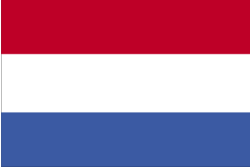Netherlands
The Netherlands is a country that lies at the western end of the North European Plain. Except for the southeastern part, the Netherlands is flat and about 40% of the country lies below sea level. The inhabitants of the Netherlands, called the Dutch, have built dikes to hold back the sea. The country is situated at the estuary of the river Rhine, which originates in Switzerland, and the river Meuse, which runs via Belgium from France to the city of Rotterdam, the main seaport of the Netherlands.
The Netherlands is highly industrialized and one of the most densely populated countries in Europe. Its surface area is 41.528 km² (of which 18,41% is water) and its 2007 population is 16,570,613. This gives 489 inhabitants per km² of dry land. The capital of the country is Amsterdam, while the government is seated in The Hague.
The Netherlands was an independent republic from 1579 until 1806, when Napoleon Bonaparte appointed his brother Louis Bonaparte as the first king of the Netherlands. In 1810 the country ceased to exist, as it became part of the French Empire. After the Congress of Vienna in 1815, the country became a kingdom with William of Orange I as the first king. His descendant, Beatrix of Orange, is now queen of the Netherlands.
Government and Administration
National Government
The Netherlands are a constitutional monarchy with a bicameral parliament. The head of state is the monarch, currently Queen Beatrix. Under the Dutch Constitution, the monarch has to approve all legislation, appoints and dismisses government secretaries, and is head of the supreme court of appeal, but in practice, the monarch's power is limited and his role is largely ceremonial. The power of the executive is vested in the Cabinet (Dutch ministerraad "Council of Ministers"), headed by the Prime Minister, currently Jan Peter Balkenende.
Legislative power is held by the bicameral Dutch parliament. The Lower House (Dutch Tweede Kamer) has 150 seats, the members of which are elected by direct proportional elections. Members have the right to propose, sponsor, and amend bills. The term of office is four years. The Upper House (Dutch Eerste Kamer or Senaat) has 75 seats. The members of the Upper House are elected indirectly by the delegates of the provincial assemblies. Members only have the right to approve or reject legislation.
Administrative Divisions
The Netherlands is divided in provinces, twelve in total:
- Drenthe - capital: Assen
- Flevoland - capital: Lelystad
- Friesland (Frisian: Fryslân) - capital: Leeuwarden
- Gelderland - capital: Arnhem
- Groningen - capital: Groningen
- Limburg - capital: Maastricht
- Noord-Brabant - capital: 's-Hertogenbosch (also called Den Bosch)
- Noord-Holland - capital: Haarlem
- Overijssel - capital: Zwolle
- Utrecht - capital: Utrecht
- Zeeland - capital: Middelburg
- Zuid-Holland - capital: Den Haag (also: 's-Gravenhage; English: The Hague)
International Relations
The Netherlands are a founding member of the European Economic Community, which evolved into the present European Union. The country is also a member of NATO and the United Nations.
History
Prehistory and Conversion to Christianity
It is believed the area of land now known as the Netherlands was inhabited from as early as 150,000 BC. Historical records date back to about 57 BC, when Roman armies under general Gaius Iulius Caesar invaded and occupied the southern portion of the Low Countries. The northern frontier of the Roman Empire ran along the Rhine river through the Netherlands. The Romans established a number of fortifications along this frontier which became centers of trade. Germanic tribes living north of the frontier, such as the Frisians were still heavily influenced by Roman culture through trade contacts. As the Roman Empire disintegrated, Roman armies withdrew from the Netherlands by about AD 406.
In the early centuries after Christ, the Low Countries were inhabited by numerous Germanic tribes who had an agricultural society. By the third century, these tribes organized into larger federations and three main groups emerged: the Franks in the South, the Saxons in the East, and the Frisians in the North and West. Little is known of the pre-Christian pagan beliefs of the Germanic tribes, though it seems that Wodan and Donar were worshiped by the Germanic tribes in the Low Countries.
References
See also
- P.J.A.N. Rietbergen. A Short History of the Netherlands. From Prehistory to the Present Day. 5th ed. Amersfoort: Bekking, 2002. ISBN 9061094402
